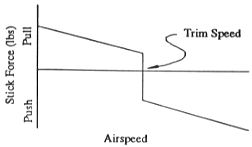This is stretching somewhat beyond the realms of everyday PPL'ing, and isn't something which readily requires thought on the part of a GA pilot, however the effects of friction (or more often 'stiction') and backlash in the control circuit can presents some handling challenges.
When considering the pitch stability of an aircraft (which directly impacts on the ease by which a pilot can control an aircraft), engineers and Test Pilots will define this in a few different ways. Relevant to this discussion is a commonly used measure called the stick force gradient, or stick force versus airspeed.
Let's say you were flying an aircraft that was perfectly trimmed out for straight and level flight. If I now asked you to hold an airspeed 10 knots higher without retrimming, you would find yourself (in a well designed aircraft), having to keep a constant force pushing the stick forward. If I asked you to go another 10 knots faster, you'd have to push even harder at a constant force. If I then asked you to come back to your original airspeed, you should eventually reach a point where you can take your hands off the controls and it holds your trimmed airspeed again.
Now in a well designed and certified aircraft, it is required that this force between changing the speed from trimmed, to 10 knots different, to 20 knots different, is reasonably significant (for large FAA type aircraft, the requirement is for a minimum of one pound-force per six knots), and linear (that is, the force to hold 20 knots is double that at 10 knots).
A well harmonised aircraft that exhibits these characteristics will tend to be easier to control and trim out.
Now in reality, the aircraft controls are a mechanical system, so will experience some freeplay, friction and so on. The effect of this is a deadband around your trimmed airspeed.

(Borrowed from the interwebs)
If you look at this graph, you will see that to reduce the airspeed, a pull force is needed, and to increase the airspeed, a push force is needed. However around the middle of the trim speed, you can push or pull the controls a little bit and nothing happens. This is where you are 'taking up the slack' in the control runs.
So bringing this all back to the original question - If you have a control jam like that you're describing, you may find that the initial movement of the trim wheel takes up some of this slack in the controls. My expectation is that in the event of this very rare type of control jam, you would take up controlling the aircraft in pitch using the throttle.
(P.S. For those that have made it this far without falling asleep - Well done, and don't worry, none of this is on the PPL theory exams!)


 FLYER Club Member
FLYER Club Member